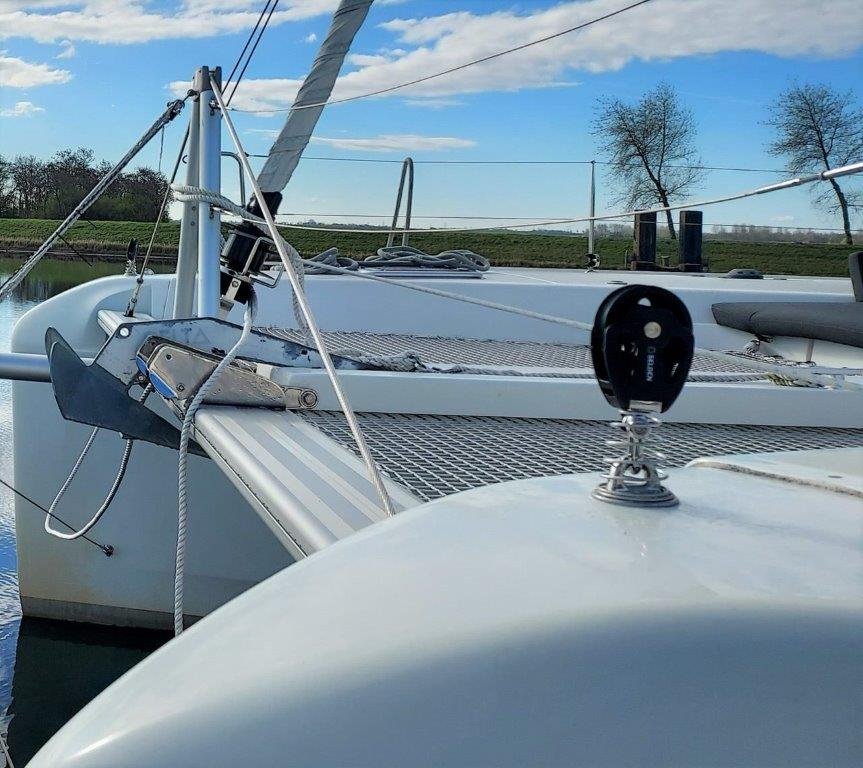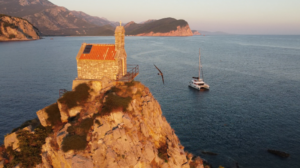‘You’re not born with experience’. A nice statement by a sailor during a conversation in which we told that we had bought a new kind of sail for us: a parasailor (bought at Bomarine). It’s like a gigantic ‘kite’ of 152 m² that hangs in front of your sailboat and pulls the boat forward. So, sometimes, you do want to have that experience, before you get into such a new sailing situation.
So I was happy that we got instruction by Bojan on the Haringvliet about how the parasailor works. It was a hands-on training: a 1 time demonstration, sailing back and then do it yourself.
But first more about why we bought the Parasailor, why now and how it works.
Why a parasailor and why now?
Since we bought the catamaran in 2019 we have had 3 sails: the main sail, the jib and a Code Zero. The Code Zero is a cross between a genoa and an asymmetrical spinnaker that is used for sailing broad to the wind in light air. So up to 18 knots you can use this sail. When you want to make optimal use of wind blowing at the rear of your ship, you better use a parasailor. It’s a bigger sail that can handle wind up to 30 knots. That has to do with the open airfilled wing half way the sail, which makes sure the wind can escape a bit and create lift and propulsion while sailing.
Why this parasailor now? In April we start to sail along the West coast of Europe (from Belgium to Portugal) where there usually is a lot of Northern wind, so a parasailor is ideal to keep speed high while sailing. Also, when we later want to make the crossing from Europe to the Caribbean, this sail is ideal to make use of the trade winds that blow from east to west over the Atlantic Ocean.
How does a parasailor work?
It is based on the principle of a surfkite: the sail is hoisted in front of the ship and pulls the boat upward and forward. You make use of 5 lines: 1 on top of the sail connected to the top of the mast. And 4 lines at the bottom of the sail, to keep the sail in place. And 2 of the 4 lines are used to steer the sail. That also means we had to install 2 new roller blocks on our ship: completely in the front of the two hulls. These will take of the lift forces. The 2 other lines are going to the rear of the ship on the block rollers from the existing Code Zero. And these 2 lines take care of the forward propulsion.
The open wing in the sail makes sure the sail can handle a lot of wind and the roller blocks enable the sail to turn a bit as the wind changes. Once you have hoisted the parasailor it practically handles itself during the sail as long as you make sure the wind stays at the rear (of side) your ship.
Our first experience parasailing
In the video below you see our first hoist of our new parasailor when we sailed on the Haringvliet. The wind was NE, and the Haringvliet is long, but not that wide, so the practice was short and fast. But we managed to hoist the parasailer and do a jibe also. As you can see in the video, you pull it out of a plastic ‘sock’ and the sail unfolds itself when you pull the sock up. And especially the wing is impressive when it opens up half way. The sail sets itself quickly and because it’s lifted fairly high above your ship, you still have a good 360 degree view from the helm around your ship.
We are excited about this sail and hope to use it a lot!









